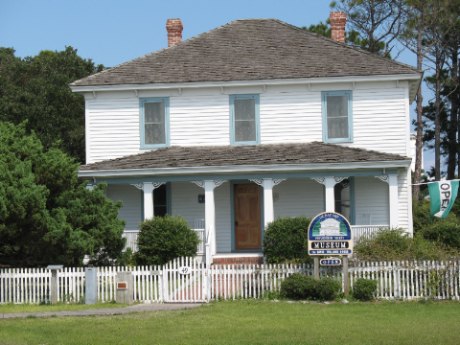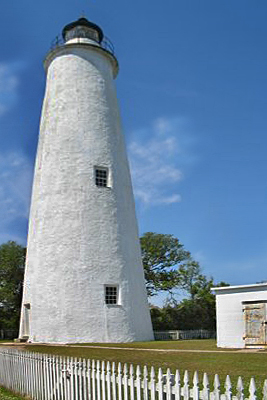“Don’t be such a dingbatter,” my grandmother used to say to my sisters and me. Another of her favorites was: “go to the store that’s katty-whompus from your house and get yourselves some penny candy.” We knew what she meant. We grew up with these words. A dingbatter was a silly or foolish person. Katty-whompus meant across the street diagonally. But they weren’t words commonly used by our friends, or anyone else we knew, for that matter. So imagine my surprise when I wandered into the Ocracoke Preservation Society Museum and found those exact same words on an educational display!

Ocracoke Island, an isolated 16-mile long strip of sand that is home to only 800 residents, is perhaps the most fascinating destination on the Outer Banks of North Carolina. Historically a fishing and whaling village, this tiny island was so remote and isolated from the rest of civilization that native “O’Cockers” developed a unique manner of speaking.
The isolation of the island began changing a number of years ago when the State instituted a ferry service. Soon, tourists were flocking to Ocracoke and the old way of life began to disappear. Today there are only a few remaining O’Cockers who speak in the old brogue, and most of them refuse to speak to tourists. Indeed, when I lived on the Outer Banks, I frequently spent weekends on Ocracoke and often encountered O’Cockers who pretended to be deaf rather than speak to you. Fortunately, the O’Cocker language will be forever preserved through the efforts of the Ocracoke Museum.

Housed in a historic white clapboard house, the museum contains historic furnishings; artifacts from Fort Ocracoke, a Confederate Civil War fort that was abandoned and destroyed; and displays about whaling and commercial fishing, which was for 250 years the lifeblood of the community. But the most fascinating feature of the museum is the “Brogue Room,” which contains extensive research about the unique linguistics of the island and features a video of native O’Cockers speaking in their unique accent (view three short video clips featuring native O’Cockers speaking in the Ocracoke Brogue: clip #1, clip #2, and clip #3).
The first time I pulled up a metal folding chair to watch the video, I was shocked. While much of what they said was unintelligible, I easily recognized the words “dingbatter” and “katty-whompus.” Fascinated, I began reading the displays to determine why I knew these words. I soon had my answer. The earliest residents of Ocracoke were fishermen who emigrated from southwestern England. This is where my grandmother was born and it must have been she who handed down these words.
Ocracoke is one of the most fascinating travel destinations in the U.S. In addition to the museum, the island offers miles of gorgeous undeveloped Atlantic beaches, an historic 1823 lighthouse, a World War II British Cemetery, wild ponies, hurricane lore, and a long history of piracy. Ocracoke is easily accessed by ferry from either Hatteras Village to the north, or the North Carolina mainland (Swan Quarter or Cedar Island) to the south. There is no charge for the ferry from Hatteras and both the Cedar island and Swan Quarter ferries levy one-way charges of $1 for a pedestrian, $3 for a bicycler, $10 for a motorcycle, and $15 for a vehicle of less than 20 feet in length.

We just returned from a short stay on Ocracoke and the Island is starting to come to life. There is a new Italian restaurant, oddly called Riley’s, that is quite good, but the best meal was the seafood platter at the Flying Melon. Lots of sales — which I’d never seen there before — at the local shops. We rented a house called Pipe Dream. It was a real pad and affordable but the highlight was the guest book. I guess a couple of nudists used to live next door and put on quite a show for the renters. Some of the guest had strong opinions on the subject!
Loved the story and the pictures. Interesting sidenote – I grew up on the opposite coast in California with family roots going as far east as Colorado. We grew up using catty-corner instead of katty-whompus, tho I’ve heard that word (phrase?) as well. 🙂
Kaye – SandwichINK’s last blog post..SandwichINK Welcomes YOU to the 2009 Blog Party
Hi there. I followed a link from my own blog’s BlogHer ads and found this wonderfully informative post. Ocrakoke is on my “bucket list” because I hear that there are some great shelling conditions at certain times of the year. I live near Sanibel Island in Florida, where I’ve collected lots of great sea shells from the Gulf beaches – would like to expand my collection to include some Atlantic species, some days. Anyhow, my own link was featured on the BlogHer ad today too, just under yours – in case it is gone by time you see this, I’ll leave one here in the comments, too.
Tink *~*~*
NEW at My Mobile Adventures *~*~* :
A morning at Ding Darling Wildlife Refuge, Sanibel Island
I haven’t been here specifically, but have been to North Carolina. My brother and his family live there. Love that word 🙂
Jennifer, an ordinary Saffa girl’s last blog post..Still waiting…
I too traveled through Ocracoke once…I was going to Va Beach and as I’m apt to do, decided to take a more scenic route. It was charming…and I loved taking the ferry!
June’s last blog post..Nowpublic.org
I went there once and thought it was fascinating. I heard a native address another man as “Sire.” I love that place.
Rhea’s last blog post..Random Dog Park Observation